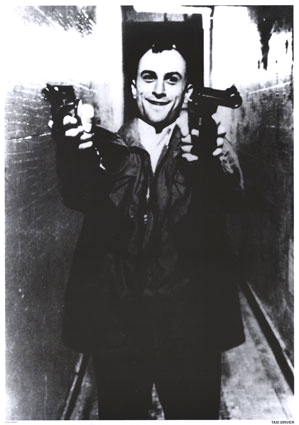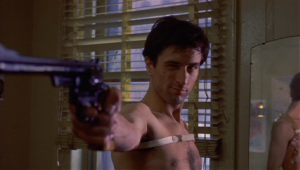Voices In Our Heads
You talking to me?
It is the pivotal scene in Scorsese’s Taxi Driver and it remains one of the seminal moments in movie history. Not so much because of its improvisational nature, or the uncanny way Robert De Niro (playing the alienated and ultimately violent Travis Bickle) disappears into this character, managing to seem invisible and menacing all at once. Most important, this short scene echoes a question that all of us, to a certain extent, ask the world every day.
“Are you talking to me?” we ask, and the tone may be inquisitive, rhetorical or defiant. It may be those and many other things. Mostly, as we interact in a mechanized, sped-up and increasingly unreal reality, we want to make sure people know we are there. We use our voices, our eyes, our frowns or smiles, our horns, our phones, our e-mail, our clothes and a thousand unspoken thoughts to affirm that our presence does not go entirely unnoticed.
In a way, it was easier a few decades ago, around the time Taxi Driver (1976) was released. There was no Internet, no texting, no cell phones, no cable TV, no electronic anything. If you needed to reach out and touch someone, you had to do just that. It’s possible that with the proliferation of devices and toys, in our information-overload moment (which, as it relates to art, content and information, is definitely not a negative thing), we are lonelier than ever before. This ground has been well-covered and there are compelling arguments on either side. On one hand, it can be conjectured that by remaining indoors, behind a glowing screen, we’ve effectively cut ourselves off from old-fashioned interaction and our communication—however ceaseless—lacks intimacy and engagement. On the other hand, people who in another era (including this one) may be best described as socially awkward (due to a variety of societal and self-imposed factors) have myriad opportunities to connect that simply did not exist even ten-to-fifteen years ago.
And the above observations almost entirely relate to action as opposed to reaction. It’s difficult to accurately gauge precisely how a constant bombardment of content, opinions and steadily louder voices is affecting our perception. Not too long ago it was a common joke to talk about (either in celebratory or castigating tones) how we had one hundred channels to choose from via cable TV. Now we have hundreds of channels, as well as streaming video, social media, blogs, and a dedicated website for every news channel, program and talking head in the world. And all of these voices are trying to tell, or sell, us something. Always urgently, never off message, constantly competing with all the other noise to get inside our heads and influence our opinions in one way or another.
Who Owns The American Dream?
You’re in a hell, and you’re gonna’ die in a hell like the rest of them.
It was horrifying enough when we had Travis Bickle types who, for their various reasons, sought violent ends to make some type of statement or try and quell that voice screeching non-stop in their ears, like a demented wasps’ nest. Taxi Driver, though wrongly or at least simplistically described by too many as the story of a psychopath, is very much a cautionary tale about what can happen when an alienated citizen has no one to talk to. The fact that it’s set in one of the busiest cities in the world is less ironic than tragic: anyone who has spent time in a bustling urban environment can confirm that it’s sometimes—if not often—the case that one can feel most alone when surrounded by millions of people who don’t know or care about them.
Loneliness, alienation and even violence are sufficiently commonplace as to be unremarkable facets of American existence: watch the news or consider your own life story. This certainly holds true in any society, particularly our plugged in but often disconnected post-millennial era. It seems safe to suggest these conditions are most rampant and profound in the United States. There are countless reasons and/or symptoms, and they are rooted more in myth than reality. For instance, while America does not have the rigid and stratified class systems that still plague Europe, we do have a collective addiction to the white-washed fantasy also known as the American Dream.
Lest that sound like a facile dismissal of a very complicated and, in many ways useful illusion, there are undeniably certain aspects of the American Dream parable that are provable and worthwhile. The ceaseless influx of grateful immigrants is sufficient testament to the inherent promise of an ostensibly free society. The same promise luring men and women to illegally enter our country is the same impulse that served as a siren song for Irish, Italian and other immigration movements through the 19th and 20th centuries. And yet, this speaks to the dream of America itself more than what we call the American Dream. Being able to do something is altogether different from being able to do anything. Most of these immigrants (then, now) are obliged to work excruciating hours doing horrific work at woeful wages, and the only thing making it tolerable is that it is (usually) better than the alternative.
The proposition that any of us, regardless of who we are and whatever our initial station in life can, with the correct combination of industry, initiative and luck, ascend to a status of wealth festers as one of the more powerful, if poisonous fictions our country has produced. More, it is not merely promulgated but actively inculcated: history books and sentimental movies tend to tout the exceedingly rare rags-to-riches allegory while ignoring, denying or conveniently dismissing the typical reality, which is that the working poor are likely to remain exactly where they are. In fact, as we’ve seen in the last few decades, this is more—not less—the case in a political and cultural system that has steadily ensured that those who have more will get more, usually directly at the expense of those who have little.
This dichotomy between what we see on screens or inside magazines is not new, but commercials, ads and websites telling us how can be or who we should be are incalculably more prevalent and powerful in today’s world. Thus, the same types of alienating forces that the lonely, angry and outcast citizens have historically been subject to are alarmingly more intense in a 24/7 info-tainment unreality. Which brings us to the Republicans in general and the Tea Party in particular. The GOP has auto-piloted the Horatio Alger story to the extent that counties receiving the most federal aid will lash out most indignantly (if ignorantly) about the perils of “big government”. Indeed, generation after generation illustrates that those who benefit most from higher taxes (and who have the least likelihood of ascending to the upper tax brackets) are consistently fanatical about keeping taxes low for those who earn the most. There are an unfortunate number of tragedies we commit as Americans, but this is one of the more profound examples.
Someday A Real Rain Will Come…
Loneliness has followed me my whole life…there’s no escape. I’m God’s lonely man.
One of the more devastatingly poignant (or poignantly devastating) scenes in Taxi Driver occurs when Travis sits, silently in his apartment, watching the attractive and fashionable folks dancing on TV. Alone in his sweltering studio walk-up, the look on his face—at once longing, frustrated and confused—reveals the hastening recognition that he will never attain the easy, if superficial, security he sees on the screen. With subtlety and lack of sentimentality (the script is actually somewhat slight, which only underscores the astonishing work De Niro turns in), we see that Bickle is the ultimate loner, an underground entity who is as much insect as human, scurrying in and out of his pointless and preordained routine.
Add to this the fact that he is a veteran, perhaps the most overlooked, yet prescient touch of the film (flash forward thirty-plus years to see how we treat our soldiers when they return from the wars we ask them to fight; little coincidence that it’s the same party that salutes the flag most tearfully who are quickest to slash and burn the programs designed to provide physical—and especially mental—assistance). The result of these circumstances and lack of choices provide us, circa 1976, with a character sketch of someone who, if one thing leads to the next, might opt for a more sociopathic solution to his problems. Importantly, Bickle is not revealed as a man destined to snap; while he is far from blameless for his predicament, he is very much a casualty of the world (the real one and the manufactured one) that he can’t master but must exist in. Therefore when he decides “my whole life is pointed in one direction…there never has been any choice for me”, it is both a confession and a one-man verdict, his indictment against this world.
There is some irony, looking back on the candidate he turns his grim attention toward: Palantine, running under the campaign slogan “We Are The People”, seems to espouse a very optimistic (if clichéd) message. (Further irony in that this notion of a collective synergy only amplifies Bickle’s isolation.) Imagine all of these elements contributing to Bickle’s disintegration placed in the context of our contemporary culture, with venom being spewed 24/7 by charlatans and circus clowns like Beck, O’Riley and Palin. Imagine Travis Bickle watching Fox News each day. If you can, you may begin to see why the concern and loathing of the Tea Party movement had much more to do with what happened this week in Arizona and little to do with comically misspelled signs and morons telling the government to stay out of their Medicare.
Travis gets his guns after a frightening encounter in his cab (and having heard about the violence fellow drivers have suffered). Only after he feels himself finally out of options does he contemplate using his gun on an innocent person (and later, people). Even in 1976, this was sufficiently compelling commentary on the ease with which Americans get access to guns. Today, appallingly, gun laws are looser than ever (and—shocker!—one political party defends this madness with the same tenacity they bring to cutting taxes and eliminating federal aid programs) and instead of a lone madman with one round, we have the sickening spectacle of semi-automatic weapons. Flash forward to Columbine, Virginia Tech and Tucson.
It slowly comes into focus: it is easier, now, for more people (except perhaps the politicians and mainstream media, the two most culpable parties) to understand the calculus that made this weekend’s tragedy predictable and, perhaps, inevitable. There are and—as ass-covering TV talking heads remind us—always will be lunatics in our midst who will kill and maim others and there is little we can do (other than disarm them). That said, it is way too easy to suggest this was an ambivalent act with random victims: in the same state the cretinous Sarah Palin put gun-sights on in a map of “targets”. It’s not necessary to pile on Palin, no matter how much blood she has on her carefully manicured hands; it is every bit the supine and opportunistic media’s fault, since they have breathlessly provided this imbecile with a public platform every step of the way. Special disgust, certainly, must be reserved for the reprehensible propaganda machine at Fox News: that so many Americans receive their “information” (and/or marching orders) from these scavengers debases us all.
And so, while the GOP gleefully fed the ill-conceived ire of the Tea Party faithful, they continued to double down on the very things that have caused so many of these folks to feel genuine hardship. It would almost be comical, except for the immorality and the guns. If someone in a red (or blue) state wants to endorse candidates who blithely promise to increase the collective misery, one can only laugh—unless one can’t help but cry. But when we see these candidates urging “Second Amendment remedies”, we need not wring our hands and ask how we all share the blame. No, the bulk of the blame can easily be laid at the spit-shined shoes of the pied pipers leading these rats to the water’s edge. That, an older and/or more cynical observer might suggest, has always been the case. Except now these rats are packing heat and they don’t mind taking out as many of us as they can, smiling as they do it.




